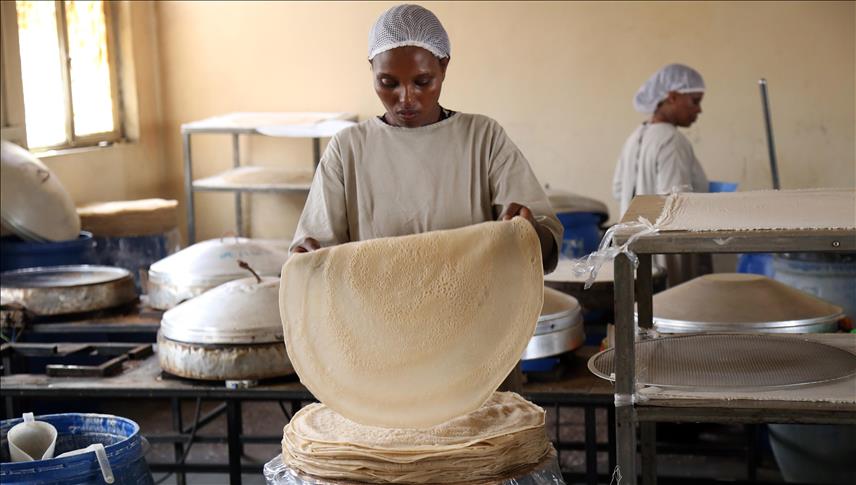 ADDIS ABABA, ETHIOPIA - OCTOBER 14 : Woman make pancake like spongy bread called injera using flour made by the teff, staple crop in the East African country that yields a mixed red-and-white seed the size of a poppy, in Addis Ababa, Ethiopia on October 14, 2017.
( Minasse Wondimu Hailu - Anadolu Agency )
ADDIS ABABA, ETHIOPIA - OCTOBER 14 : Woman make pancake like spongy bread called injera using flour made by the teff, staple crop in the East African country that yields a mixed red-and-white seed the size of a poppy, in Addis Ababa, Ethiopia on October 14, 2017.
( Minasse Wondimu Hailu - Anadolu Agency )
By Seleshi Tessema
ADDIS ABABA
As global demand for Ethiopia’s gluten-free indigenous staple crop grows, officials and businesses are looking to tap the global market by modernizing the ancient crop, letting its healthy taste spread worldwide.
Teff is a staple crop in the East African country that yields a mixed red-and-white seed the size of a poppy.
Ethiopian consumers buy the seed from farmers or traders and ground it into flour to make a pancake-like fermented spongy bread called injera, which can be consumed two or three times a day.
According to the UN’s Food and Agriculture Organization, teff accounts for about two-thirds of the daily protein intake in the Ethiopian diet.
‘Like coffee, teff is ours’
“Teff is as old as Ethiopia,” said Esayas Lema, deputy head of the Agricultural Extension Program of Ethiopian’s Agriculture Ministry.
“It was first discovered by Ethiopian farmers, who have been cultivating it for more than 3,000 years,’’ he said.
“And like coffee, teff is ours, it is Ethiopia’s gift to the world.’’
Some 6.5 million farmers produce 44 million quintals (a unit equal to 100 kilograms) of teff every year.
“Due to the introduction of better seeds and farming technologies, production has risen more than 40 percent over the last five years,” Lema said.
Teff is farmed and consumed in nearby Eritrea and South Africa as well as the U.S., Australia, Canada, the Netherlands, Spain, and India.
However, Lema said, more than 90 percent of the world’s teff is grown in Ethiopia. In 1886, Britain’s Royal Botanic Gardens took the crop and sent it to be grown in North America, Europe, and Africa.
Healthy food crop
Temesgen Aweke, a researcher with Ethiopia’s Health and Nutrition Research Institute, said teff is blessed with unique characteristics that make it a healthy food.
“First, teff is not genetically modified and it is gluten free,” he said, “It is also high in fiber, and rich in iron, calcium, magnesium, protein, and amino acids.”
According to the FAO, teff is low on the glycemic index, making it a good food for people with type 2 diabetes.
Aweke added that over the last decade teff has been recognized as one of the world’s ancient dietary staples, joining the likes of quinoa, farro, spelt, and millet.
“Compared to quinoa, and other ancient grains, teff contains more calcium, iron and vitamin C,” he added.
Rising global appetite
Teshome Seleshi, a brand expert with the Ethiopian Intellectual Property Rights Office, told Anadolu Agency that the global appetite for teff has been growing over the past decade.
“As consumers in North America and Europe have developed an appetite for teff, many companies, particularly from India and South Africa, have responded to the demand by cultivating and selling teff flour to health food shops,’’ he said.
A Dutch firm, Health and Performance Food International (HPFI), which in 2005 signed an agreement with Ethiopia to promote teff’s use in Western cuisine, partially contributed to the crop’s popularity, according to Seleshi.
“The company put teff into pasta, protein bars, pancakes, pizza, juice, and soup,” he explained.
Export ban
Despite the growing demand, in 2006 Ethiopia banned exports of raw teff and flour, after the price of the crop skyrocketed, panicking consumers. (The ban does not include injera.)
Mama Fresh is one of the companies that since 2003 has baked and exported injera to various parts of the world.
“Six days a week, we use Ethiopian Airlines to export 6,000 pieces of injera,” said, Hailu Tessema, the company’s CEO.
“We also air deliver injera to Australia, Norway, Sweden, Britain, Canada, Nigeria, and Kuwait, three days a week on average,’’ he added.
Over the last couple of years many local companies also entered the business, and all the firms export more than 30,000 pieces of injera to Washington and New York every day, he said.
“As injera is no longer a food only consumed by the Ethiopian diaspora, the demand keeps growing 10-15 percent every month,’’ he added. “
“The supply is way below the demand.’’
Tapping the global market
Dereje Bezu, a businessman thinking of doing teff exports, said that the ban should not last forever.
“Once the global market is saturated, it will be difficult to compete and sell,’’ he said.
“The government should provide incentives for large-scale farming, and ease the ban.”
The Agriculture Ministry is cautiously optimistic that after ensuring domestic supply, Ethiopian farmers would be able to export the grain.
But according to Mama Fresh’s Tessema, exports of value-added teff provide a legal route to the global market. “The government allows and supports exports in this form.’’
“Accordingly, we have finalized preparations to build a huge modern factory that in a year or so starts producing various teff-based types of foods and injera as well.”






